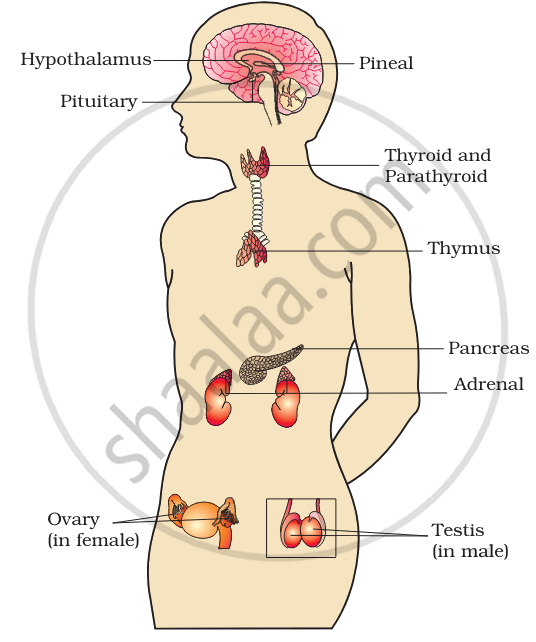Advertisements
Advertisements
Question
Diagrammatically indicate the location of the various endocrine glands in our body.
Solution
The location of various endocrine glands in the human body can be illustrated as follows:

APPEARS IN
RELATED QUESTIONS
| Hormones | Target gland |
| Thyrotrophin (TSH) | ______ |
Give an example of a progestational hormone.
Fill in the blank:
Hormones are produced by ____________.
Give the special function of the following:
Corpus luteum
Define the following:
Exocrine gland
What do you mean by endocrine system?
What is the chemical nature of hormone?
Is the following gland an exocrine or an endocrine gland?
Salivary gland
Hormones are called ‘chemical messengers’.
Differentiate: Acromegaly and Myxedema.
Give the Technical Term: Name two hormones secreted by the alimentary canal.
Give the Technical Term: Name a hormone which controls developments of male secondary sexual characters.
Place the words at the bottom of the page next to the number that shows the location of the Endocrine Glands.

(1) ________
(2) ________
(3) ________
(4) ________
(5) ________
(6) ________
(7) ________
(8) ________
(9) ________
Pancreas Hypothalamus Pituitary Parathyroid Ovaries Adrenal Thyroid Thymus Testes
Some of the endocrine glands are shown by the guidelines.

(i) Name the glands 1 to 5.
(ii) Name any two endocrine glands which are not shown in the diagram.
(iii) Name one gland which is both exocrine and endocrine.
Given alongside are the diagrammatic sketches of some endocrine glands. Observe the figures and answer the following questions:

(i) Label the parts numbered 1 to 5.
(ii) Name the hormones secreted by (2) and (5).
(iii) Which chemicals in our body are greatly affected by hormones?
(iv) What is the chemical nature of hormones?
(v) Name the elements related to the functioning of hormones secreted by the structure (2) and (5).
State the Function
Thyroxin
State the Function
Relaxin
Human chronic Gonadotropin:
Differentiate hyperglycemia from hypoglycemia.
Growth hormone is important for normal growth. Justify the statement.
